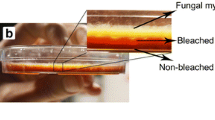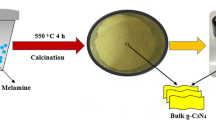Abstract
Three methods,i.e. bioremediation by application of bacteria-laden agar, physical absorption of DNT by agar, or illumination by UV light were evaluated for the removal of 2,4-dinitrotoluene (DNT) from building-grade concrete. DNT biodegradation byPseudomonas putida TOD was turned “on” and “off” by using toluene as a co-substrate thus allowing for rate-limiting step assessment. Bioremediation efficiency can be >95–97 % in 5–7 d if the process occurs at optimum growth temperature with the biological processes appearing to be rate-limiting. Sterile agar can remove up to 80 % of DNT from concrete thus allowing DNT desorption and biodegradation to be conducted separately. Photoremediation results in 50 % DNT removal in 9–12 d with no further removal, most likely due to mass transfer limitations.
Similar content being viewed by others
Abbreviations
- DNT:
-
2,4-dinitrotoluene
- TNT:
-
trinitrotoluene
- MB:
-
mass balance
References
Beklemishev M.K., Kozliak E.I.: Bioremediation of concrete contaminated withn-hexadecane and naphthalene.Acta Biotechnol. 2–3, 197–210 (2003).
Bradley P.M., Chapelle F.H., Landmeyer J.E., Schumacher J.G.: Potential for intrinsic bioremediation of DNT-contaminated aquifer.Ground Water 35, 12–17 (1997).
Datta S.K., Hollowell G.P., Hashem F.M., Kuykendall L.D.: Enhanced bioremediation of soil containing 2,4-dinitrotoluene by a genetically modifiedSinorhizobium meliloti.Soil Biol.Biochem. 35, 667–675 (2003).
Dillert R., Brandt M., Fornefett I., Siebers U., Bahnemann D.: Photocatalytic degradation of trinitrotoluene and other nitroaromatic compounds.Chemosphere 30, 2333–2341 (1995).
Fortner J.D., Zhang C., Spain J.C., Hughes J.B.: Soil column evaluation of factors controlling biodegradation of DNT in the vadose zone.Environ.Sci.Technol. 37, 3382–3391 (2003).
Gupta G., Bhaskaran H.: Use of poultry litter for biodegradation of soil contaminated with 2,4- and 2,6-dinitrotoluene.J.Hazard.Mater. 116, 167–171 (2004).
Kalafut T., Wales M.E., Rastogi V.K., Naumova R.P., Zaripova S.K., Mild J.R.: Biotransformation patterns of 2,4,6-trinitrotoluene by aerobic bacteria.Curr.Microbiol. 36, 45–54 (1998).
Kanekar P., Dautpure P., Sarnaik S.: Biodegradation of nitro-explosives.Indian J.Exp.Biol. 41, 991–1001 (2003).
Kozliak E.I., Ostlie-Dunn T.L., Jacobson M.L., Mattson S.R., Domack R.T.: Efficient steady-state VOC removal from air by live bacteria immobilized on fiber supports.Bioremediation J. 4, 81–96 (2000).
Kozliak E.I.: Photocatalyst-induced reduction of semivolatile organic chemicals absorbed in solid materials.PCT/US Pat.Appl. 2005/029904; Internat. Publ. WO 2006/023898 A2 (2006).
Kubátová A., Matucha M., Erbanová P., Novotný Č., Vlasáková V., Šašek V.: Investigation into PCB biodegradation using uniformly14C-labeled dichlorobiphenyl.Isotop.Environ.Health Stud. 34, 325–334 (1998).
Kumar S., Davis A.P.: Heterogeneous photocatalytic oxidation of nitrotoluenes.Water Environ.Res. 69, 1238–1245 (1997).
Low G.K., Mcevoy S.R., Matthews R.W.: Formation of nitrate and ammonium ions in titanium dioxide mediated photocatalytic degradation of organic compounds containing nitrogen atoms.Environ.Sci.Technol. 25, 460–467 (1991).
Müller R.H., Müller R.A., Jahn Y., Babel W.: Bioremediation of building material contaminated with herbicides.Environ.Sci.Pollut.Contr.Ser. 22, 121–131 (2000).
Nishino S.F., Paoli G.C., Spain J.C.: Aerobic degradation of dinitrotoluenes and pathway for bacterial degradation of 2,6-dinitrotoluene.Appl.Environ.Microbiol. 66, 2139–2147 (2000).
Peterson M.W., Turner J.A., Nozik A.J.: Mechanistic studies of the photocatalytic behavior of TiO2. Particles in a photoelectrochemical slurry cell and the relevance to photodetoxification reactions.J.Phys.Chem. 95, 221–225 (1991).
Phelan J.M., Barnett J.L.: Solubility of 2,4-dinitrotoluene and 2,4,6-trinitrotoluene in water.J.Chem.Eng.Data 46, 375–376 (2001).
Popova I.E., Sundstrom T.J., Beklemishev M.K., Seames W.S., Frihart C.R., Kozliak E.I.: Penetration of naphthalene,n-hexadecane, and 2,4-dinitrotoluene into building grade southern yellow pine softwood: a qualitative study.Forest Prod.J. 56, 68–75 (2006).
Snellinx Z., Taghavi S., Vangronsveld J., Lelie D.: Microbial consortia that degrade 2,4-DNT by interspecies metabolism: isolation and characterization.Biodegradation 14, 19–29 (2003).
Spain J.C.: Biodegradation of nitroaromatic compounds.Ann.Rev.Microbiol. 49, 523–555 (1995).
Spanggord R.J., Spain J.C., Nishino S.F., Mortelmans K.E.: Biodegradation of 2,4-dinitrotoluene byPseudomonas sp.Appl.Environ.Microbiol. 57, 3200–3205 (1991).
Zhang C., Hughes J.B., Nishino S.F., Spain J.C.: Slurry-phase biological treatment of 2,4-dinitrotoluene and 2,6-dinitrotoluene: role of bioaugmentation and effects of high dinitrotoluene concentrations.Environ.Sci.Technol. 34, 2810–2816 (2000).
Zhang C., Daprato R.C., Nishino S.F., Spain J.C., Hughes J.B.: Remediation of dinitrotoluene contaminated soils from former ammunition plants: soil washing efficiency and effective process monitoring in bioslurry reactors.J.Hazard.Mater. B87, 139–154 (2001).
Zheng Z., Obbard J.P.: Removal of polycyclic aromatic hydrocarbons from soil using surfactants and white rot fungusPhanerochaete chrysosporium.J.Chem.Technol.Biotechnol. 75, 1183–1189 (2000).
Author information
Authors and Affiliations
Additional information
This work was funded by theUS Department of Agriculture Forest Products Laboratory via cooperative agreement no. 04-JV-1111 1120-070 and by theCzech Science Foundation (Joint Projet 104 04 0686).
Rights and permissions
About this article
Cite this article
Phutane, S.R., Renner, J.N., Nelson, S.L. et al. Removal of 2,4-dinitrotoluene from concrete using bioremediation, agar extraction, and photocatalysis. Folia Microbiol 52, 253–260 (2007). https://doi.org/10.1007/BF02931307
Received:
Revised:
Issue Date:
DOI: https://doi.org/10.1007/BF02931307




